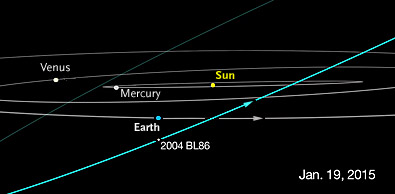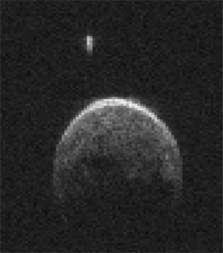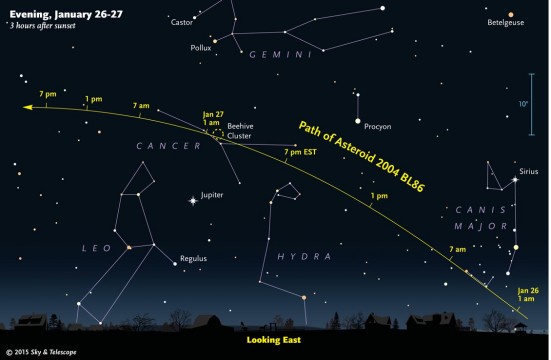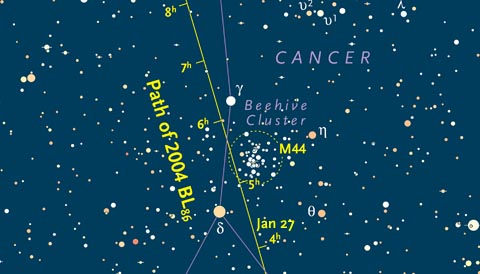With a small telescope and our sky charts, you can watch a very sizable near-Earth asteroid race across winter's constellations on the night of January 26–27.
| Update: This asteroid has a small moon! Details below. |
Asteroids that buzz close by Earth make the news either by being especially close or especially large. The one that's going to miss us on the night of January 26-27 is especially large as near-Earth objects go, and it will become bright enough to follow with a 3- or 4-inch telescope as it moves among the stars.

NASA / JPL
While most known Earth-grazers are just meters across, this one is roughly a half kilometer wide. As a result it should become as bright as magnitude 9.2 (maybe a bit brighter) shortly after it passes us at a very safe distance of 1.2 million km (745,000 miles). That's three times as far away as the Moon — and while this might not seem terribly close, remember that by comparison Mars never comes closer to us than 145 lunar distances.
The asteroid has been designated 2004 BL86, and it was discovered 11 years ago by the LINEAR project hunting for near Earth objects. Its well-defined orbit has earned it an asteroid number: 357439, perhaps making it the highest-numbered asteroid you've ever had a chance to see.
(Interestingly, once an asteroid is assigned number, it's eligible for naming — but Herbert Viggh of MIT's Lincoln Laboratory, which ran LINEAR, says no name has been submitted yet.)
"Monday, January 26th, will be the closest asteroid 2004 BL86 will get to Earth for at least the next 200 years," said Don Yeomans in a press release from NASA's Near Earth Object Program Office. Moreover, this flyby will be the closest by any known space rock this large until asteroid 1999 AN10 flies past Earth in 2027.

NASA / JPL
Planetary radar networks have imaged many near-Earth asteroids that have come this close, and both NASA's Goldstone tracking station in California and Arecibo Observatory in Puerto Rico will be used to map 2004 BL86 with 2- to 4-meter resolution.
In fact, the radar mapping yielded confirmation that this asteroid has a moon! Observers used NASA's huge radio dish at Goldstone, California, to record radar echoes from 2004 BL86 early on January 26th. "The primary is roughly 300 m in diameter and it's oblate," says Lance Benner (Jet Propulsion Laboratory, "We don't know the shape of
the moon, but it appears to be 50 to 100 m in diameter." The orbital period is 13.80 ± 0.05 hours.
Credit for the moonlet's discovery goes to Joseph Pollock (Appalachian State University) and Petr Pravec (Ondrejov Observatory, Czech Republic), who detected its signature in their light-curve observations. Those suggest that the asteroid spins in roughly 5 hours, and Benner says the radar data are consistent with that period.
When, Where, and How to See 2004 BL86
Observers in the Americas, Europe, and Africa have the best seats for when this interloper should be brightest, from 1h to 6h Universal Time on January 27th, most of which occurs on the evening of the 26th for North Americans. It will be crawling northward across Cancer, skimming the eastern edge of Beehive Cluster from about 5:00 to 5:30 UT.

Sky & Telescope diagram
Its closest approach to Earth actually occurs earlier, around 16h UT on the 26th while the asteroid climbing northward through Hydra. But at that time it's somewhat dimmer, about magnitude 10, because we'll see only a portion of its illuminated side. Its brightest time comes later, when we're looking almost directly into its fully illuminated face with the Sun behind us. After that, 2004 BL86 moves on into Lynx as it recedes.

The asteroid will be moving about 2.5° per hour while in Cancer, or 2.5 arcseconds per second of time. That's fast enough that you'll be able to see it moving in real time in a telescopic view whenever it passes close to a background star.
One good technique for fast-movers like 2004 BL86 is to identify and lock onto a star along its path, then just watch at the time that the asteroid is predicted to pass it. (Note that these charts are plotted as if you were observing from Earth's center. You're not, of course, so the asteroid might appear up to a few arcminutes from the indicated path.)
Happy hunting, and add a comment below to tell us about your success (or lack thereof) in tracking down this interplanetary visitor.
Keep tabs on all the year's celestial happenings with SkyWatch 2015, now available as a digital download.
 13
13
Comments
rulzul
January 23, 2015 at 5:10 am
The only celestial object I ever seen moving in real time with my C8 was comet Hyakutake in March 1996. I sure hope it's clear here! My Scope is non computerized so I see things the old fashined way, by knowing where to look! lol
Happy observing! 🙂
You must be logged in to post a comment.
Anthony Barreiro
January 23, 2015 at 3:42 pm
Thanks very much. I'm going to try to observe this asteroid. Could you please provide black-on white finder charts that I could print out? I would be most grateful.
You must be logged in to post a comment.
Anthony Barreiro
January 23, 2015 at 5:52 pm
Thank you. Either you just added the black and white chart, or I missed it earlier.
You must be logged in to post a comment.
Eduardo Gutierrez
January 23, 2015 at 5:09 pm
Anthony, the B/W version is here:
http://skyandtelescope.org/wp-content/uploads/2004_BL86_BW_UT.pdf
Regards
You must be logged in to post a comment.
Tom Hoffelder
January 23, 2015 at 6:35 pm
I'm only seeing two charts and not sure how useful the large scale one can be. As stated in the article, the way to find this asteroid is to lock onto a star that is close to the path. Using the IAU website to obtain an hourly ephemeris for my location, not a geocentric one, I found that the asteroid will pass very close to 34 Cnc from 19:40 to 19:55 EST, which is when/where I'll be watching for it. That of course depends on those 15 minutes being clear, which is always a long shot in Maine.
You must be logged in to post a comment.
January 23, 2015 at 8:09 pm
I am planning to watch gamma Cancer about 10p.m. pst. If it is moving there is a chance I could see it from my porch. Accuweather says rain showers are approaching for my area, but they are often wrong. I didn't even consider the black and white pdf link until I saw it in the comments. Thank you for mentioning that Anthony. My 10 inch CST stand is broken and I'm going to try to get a new one in time. I have a toy 60mm telescope, but maybe with magnification? ... hope springs eternal ... and there is still Lovejoy to admire!
You must be logged in to post a comment.
January 25, 2015 at 2:15 pm
Is there any chance of seeing the asteroid from Saudi Arabia? If yes, at what time?
You must be logged in to post a comment.
January 26, 2015 at 8:26 pm
Hi "Sky and Telescope"
Thank you very much for the map and the other info you provided on the asteroid. I'm pleased to report success from the Barnett Observatory (home of the Chesterfield Astronomical Society) in Chesterfield, England, where four of us used the 18" Newtonian to observe 2004 BL86 between 20.55UT and 22.00UT.
An added bonus was to see another body crossing the field of view at about 21.55UT travelling eastwards. Does anyone know what this might have been?
You must be logged in to post a comment.
January 26, 2015 at 9:49 pm
Tried to locate it using Jupiter as a guide. No such luck with my binoculars.
You must be logged in to post a comment.
StarChaser55
January 27, 2015 at 12:38 am
Wow, did not have luck finding this asteroid with 10x35 binoculars, but DID capture it with a Canon T2i on a 25 second exposure, ISO 3200. Took several pics and out of the batch found three that clearly show the asteroid moving across the star field in about a five minute time frame. Here is the link to the pictures - click through them to see the animation. Pretty neat!
https://www.facebook.com/photo.php?fbid=335805806629516&set=ms.c.eJwzNja1MAAiMzMjS1NDMz1jKN~%3BS0szIwsQSyje3hMibAwDnHwmr.bps.a.335805786629518.1073741838.100006002983565&type=1&theater
You must be logged in to post a comment.
Anthony Barreiro
January 27, 2015 at 3:15 pm
No luck. Solid clouds here in San Francisco. The waxing quarter Moon was a sporadic faint glow.
You must be logged in to post a comment.
Graham-Wolf
January 28, 2015 at 7:51 pm
Hello to all.
"It came, I saw, it missed".... apologies to Julius Caesar.
Managed to view NEO 2004 BL86 through my 26cm f4.9 Reflector with 30mm UWA 2 inch Termi-Nagler, from the Barber Grove Observatory (BGO) in Lower Hutt, NZ. 42.5x and 113 arcmin FOV. Rolling Northerly frontal cloud... cloudy to NW, but perfectly clear to North and North East. Whole sky clearing, but too late to see 2014 Q2 (Lovejoy), before it set low in the West.
The Asteroid predicted to pass through M44 in Cancer about mid-day NZDT, so I preset my 'scope "forward" on Xi Puppis (Mv 3.30) for an ~ 10:45 Ut "rendeavous", and placed the star in the left hand edge of the field. Between 10:43 and 10:44 UT on Jan 26th, the Asteroid passed through the field, approx half-way between Xi Puppis and HIP 38692 (Mv 7.40). At about midpoint, I frantically removed the 30mm Termi-Nagler and placed in:- a 15mm GSO Superview with 70 deg AF. This gives 85x and 49.4 arcmin FOV ( a much closer-up confirmational view). The Asteroid was ~ Mv10 and moving along at ~ 2 arcmin/ minute.
At the time it passed slightly to the right of Xi Puppis, the asteroid was some 47 deg above the local horizon I(Stellarium V0.12.4), and there was a 30% waxing Moon at 18 deg alt in Pisces... adjacent to the planet Uranus. Biely Marek reporting in "Yahoogroups/CometObs" mentions his own observations from Brno, as the comet passed through the region near M44. Mine is the only known Australasian observation (for now). I'm also aware the asteroid was seen in the UK, from the Bartlett Observatory.
2004 BL86 wasn't "mountain sized" after all... 500m is only 1 1/2 times the size of Auckland's Skytower (tallest building in Southern Hemisphere). 2004 BL84 has now been "downgraded" to 325m, with a 70m "moon". Well done, Goldstone Radiotelescope!
Clear skies (and best wishes to all)!
Graham W. Wolf:- Lower Hutt, New Zealand
You must be logged in to post a comment.
Graham-Wolf
January 29, 2015 at 8:41 pm
Hello again.
The Deep Sky area (near Xi Puppis) where I parked my 'scope, waiting for NEO 2004 BL86 to pass through... was centred on
RA 7h 53m, DEC -25:30 (Epoch 2000).
The BGO is located at -41.2287039, + 174.9032282, 3.0m amsl.
Looking on "Astrosite Groningen" I have just located a report from my Australian counterpart:- Chris Wyatt of Walcha NSW, who has posted 2 Mv estimates for the asteroid. I have also located an astrograph image from the USA taken of the Xi Puppis field, within ~ 2min UT of my own visual observations. A track is very evident. To "correct" to the teresstrrial orientation for NZ, one merely rotates the USA photo a full 180 deg. I.e:- upside down, and back to front!
Chris and I have identical GSO Research Grade reflectors.....
1/16 to 1/20 wave BK7 Primaries, each with HST style dielectric coatings, which gives our scopes an equivalent "aluminised" aperture of 32 to 34cm.
Chris's mirror is 25.4cm and 1250mm efl. He uses a 32mm PLossl. He has a ZLM 6.1 to 6.3 sky at Walcha (near the Queensland border). My mirror is 26cm and 1275 +/- 5mm efl. I usually use a 15mm GSO Superview. My site.... near Hutt Park (and ~15km north of Wellington, NZ) is usually ZLM 5.4 to 5.6. The extra magnificaton helps me see a littler "deeper", and gives a similar MLim (fov) to Chris at 1.5 to 2.0 the magnifications that he personally uses. I also have a GSO 2 inch research grade ED Barlow, with home-made extension tubes. The 2 inch 30mm Termi-Nagler (apparently a re-badged German Wollensak) is only used in "Wide Field, Deep Sky" emergencies.
The recent USA Astrograph image of the asteroid from the USA, has me feeling properly vindicated!
Clear skies to all out there.
Graham W. Wolf (N.Z.).
You must be logged in to post a comment.
You must be logged in to post a comment.